Embarking on a trek to Everest Base Camp? If so, you’re probably wondering what you are possibly going to eat for the 12-day journey. Because, let me tell ya, after clocking in 8-12 hour hiking days, you’re going to be hungry. The good news? Nepalese food has some of the very best flavors in the world. Nothing was better than winding down a day of trekking with a big plate of dal bhat!
Below is my ultimate Everest Base Camp Food Guide.
Do I need to pack my own food for the Everest Base Camp trek?
No! The trek to Everest Base Camp route is scattered with accommodations, restaurants, bakeries, and tea houses. Many of these entities offer robust menu options for breakfast, lunch, and dinner. There is no need to pack your own meals, as you will be eating at tea houses for the entirety of the trek. Budget around $20-30 USD per day for meals.
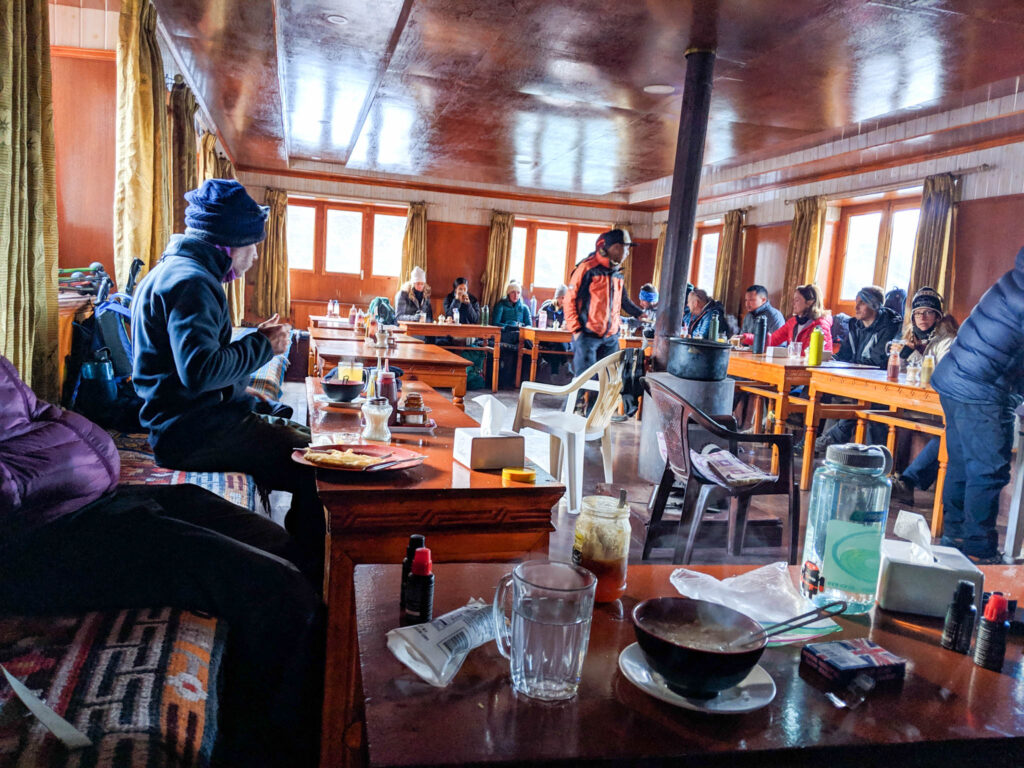
Notably, if you eat your meal in a tea house, then accommodation for the night will usually only be $2-4 USD. If you do not eat at the tea house, the cost of accommodation can rise to upwards of $15USD per night. Therefore, it is cost-conscious to eat and sleep in the same establishment.
Although you do not need to pre-plan meals for the trek, you might consider packing some of your favorite protein bars or snacks to pack along in your day pack. I packed a handful of Clif Bars and Mixed Nuts, and carried 1-2 with me each day to eat along the trail.
Check out my ultimate Everest Base Camp guide for more information.
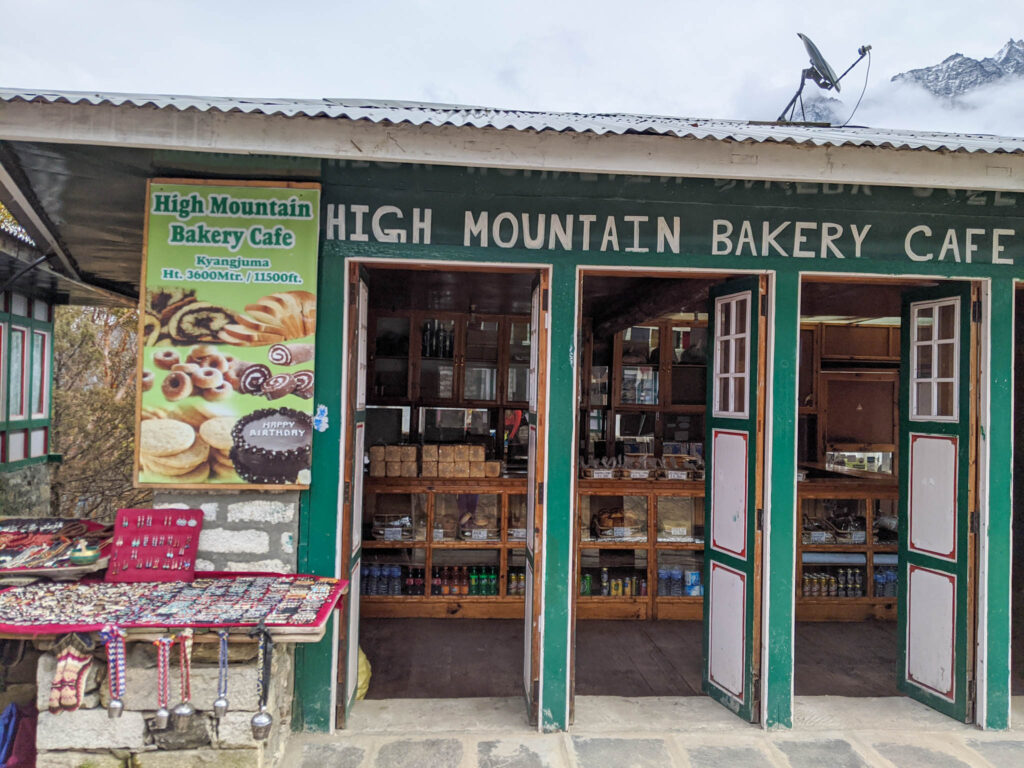
Top 5 Food Tips for the Everest Base Camp trek
Before we dive into menu recommendations, let’s explore a few key tips in regards to Everest Base Camp food and beverages.
1. Avoid Meats at Higher Altitudes
One thing to keep in mind is that all food items have to be carried by foot from one town to the next. As such, refrigeration can become a bit of a problem, especially in higher towns. Meat can spoil when not properly refrigerated, and the possibility for foodborne illness grows. It is best to avoid meat on trail to be on the safe side. But save up for a Nepalese food tour in Kathmandu! The cuisine is delicious.
2. Eat Local Nepalese Food
This is a blanket-travel hack, but I would recommend ordering local cuisine whenever possible. In Nepal, this is no exception! Local nepalese food includes Dal Bhat, Momo, Chapati, and many more mouth-watering dishes. They are always the best things on the menu… which… makes sense. Nepalese food is full of incredible spices and flavor. You certainly don’t want to miss it!
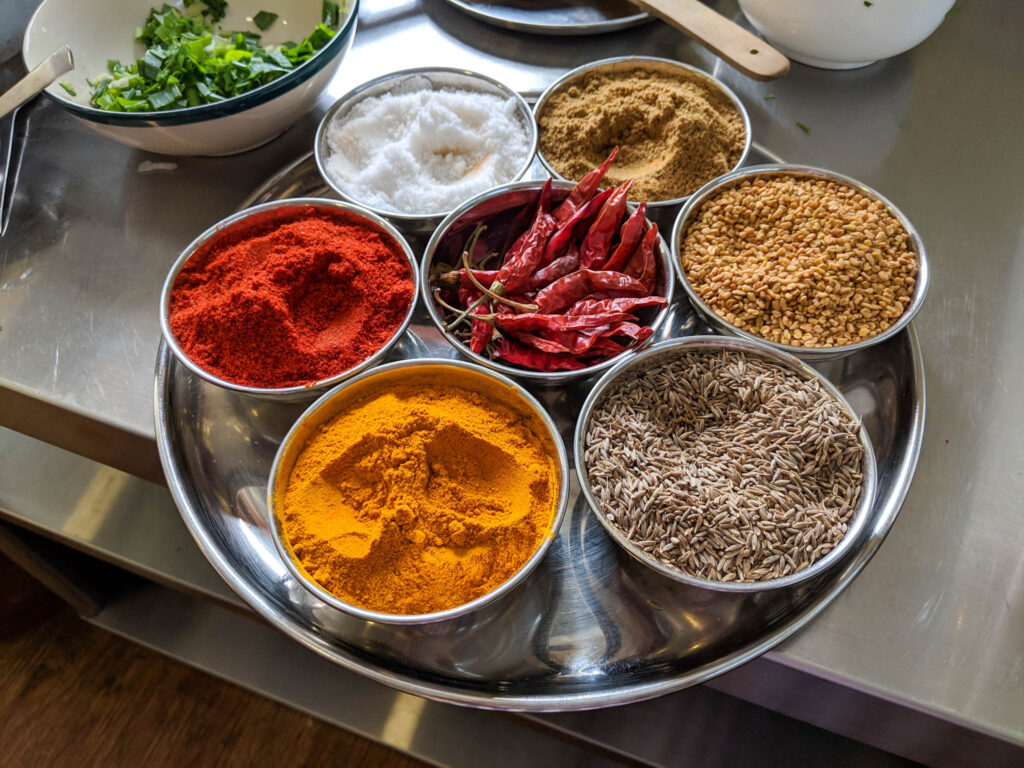
3. Avoid Caffeine & Alcohol
I am a massive coffee drinker. But decidedly gave up caffeine for our ascent on the Base Camp trek. Caffeine and alcohol exacerbate altitude symptoms, so it is best to avoid them and stick with tea.
4. Purify Your Water
Westerners cannot drink the tap water in Nepal. It is therefore very important to bring some sort of purification method along to make sure your water is clean. You’ll need to hydrate… a LOT.
5. Eat Often
Eating is SUPER important. A potential side-effect of altitude is loss of appetite. On some days, you might not want to eat anything. I cannot stress to you how important eating on the trail is. Even if you are nauseous and full, still try to eat three meals per day to make sure your body is physically ready to handle the altitude and the intense calorie-burning hike.
Okay! With those items in mind, let’s continue on to what items are recommended for breakfast, lunch, and dinner!
Breakfast on the Everest Base Camp Trek
Breakfast is non-negotiable on trail, as you’ll likely be hiking 4 hours before lunch. Tea houses offer a vast breakfast menu ranging from oatmeals or pancakes to full breakfasts of eggs, bacon, and toast.
You’ll eat breakfast in whatever tea house or accommodation you spent the previous night in. Be sure to place your breakfast order with the accommodation the night before, so the kitchen has time to prepare it.
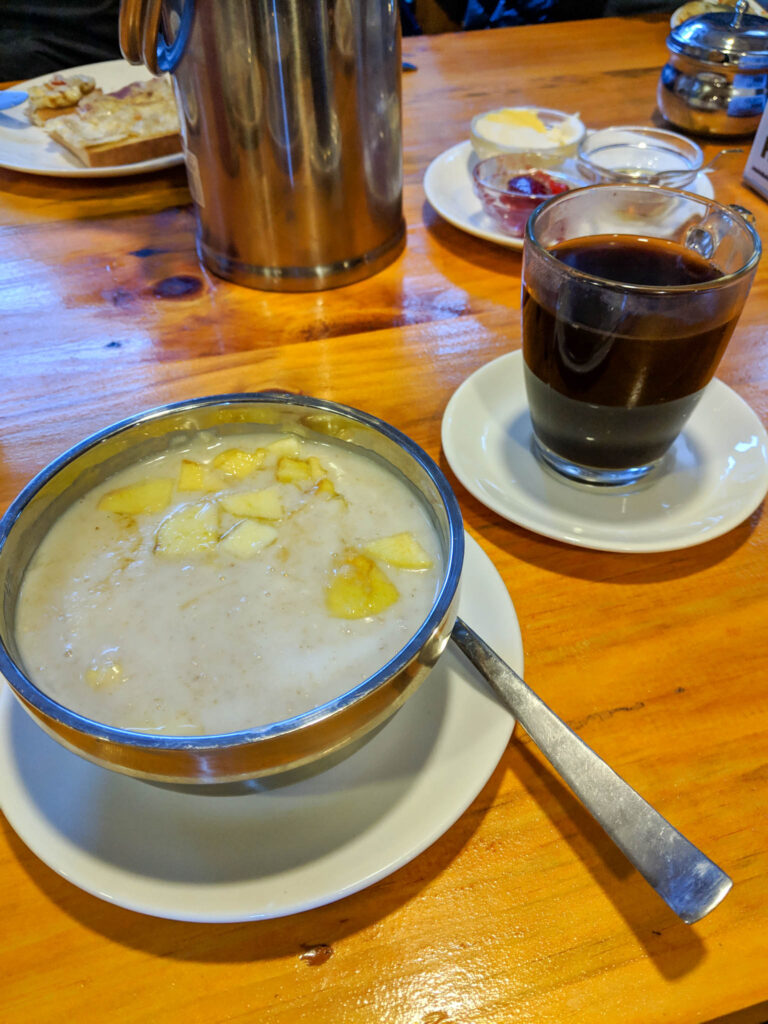
I found that the porridge with honey and apples kept me sustained for a long morning of hiking, whereas the pancakes rushed through me. Some tea houses will offer Nepalese food classics, like Chapati (Roti) or Tibetan Bread with eggs – which was always a winner!
Recommended breakfast Options:
- Apple Porridge
- Honey Porridge
- Muesli with Milk
- Tibetan Bread
- Apple Pancake
- Veg Omelette
- Scrambled Eggs
- Chapati with Eggs
Again, I recommend weaning off the coffee and sticking to tea in the mornings to minimize the effects of altitude – which you will, undoubtedly, be feeling.
Lunch on the Everest Base Camp Trek
Lunch is the only meal where you will not be eating at the same place where you sleep (unless it is an acclimatization day). Typically, you will stop off for lunch in one of the towns that you pass through along your hike for the day.
Lunch was often my smallest meal of the day, sandwiched by a large breakfast and large dinner (with a handful of trail snacks in between). But the meal options for lunch are superb – ranging from noodles and rice, to pizzas and spaghetti. I recommend eating a carb-heavy meal for lunch, and sticking to local cuisine, where possible.
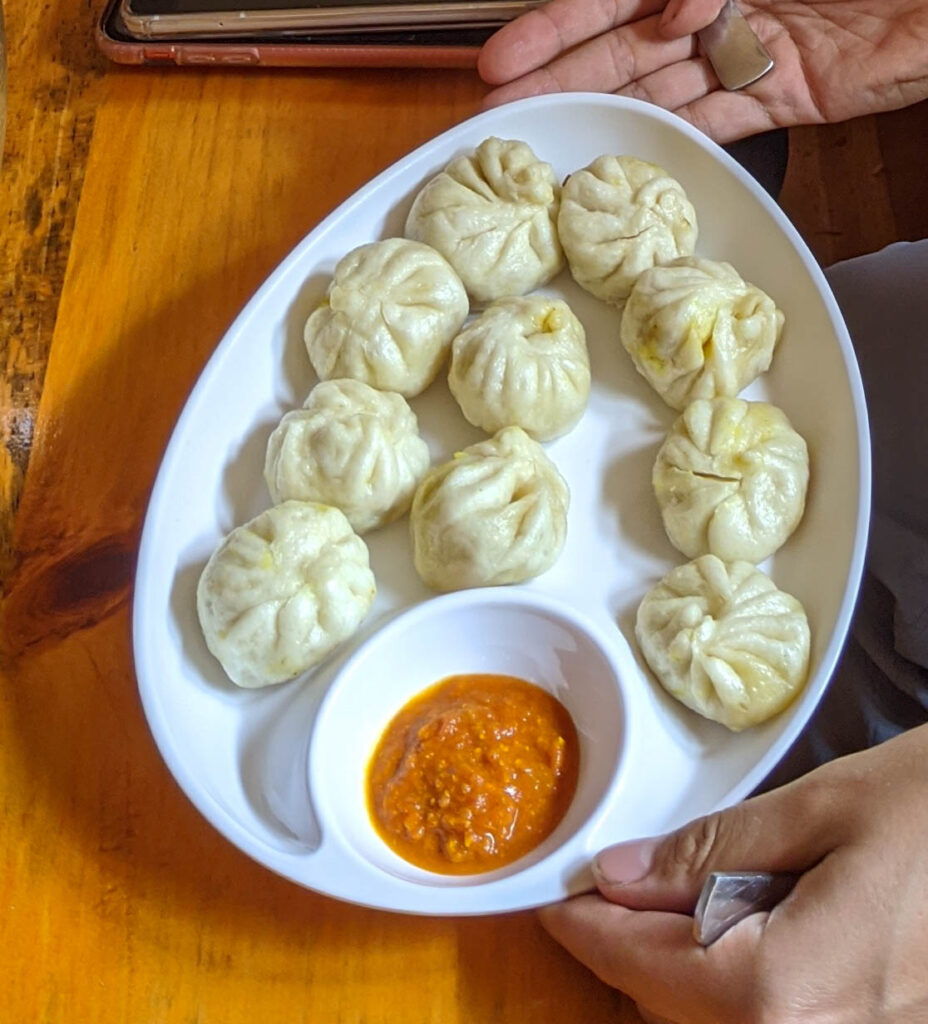
Recommended Lunch Options:
- Vegetable Fried Rice
- Vegetable Fried Noodles
- Egg Fried Noodles
- Vegetable Momo (dumplings)
- Potato Momo (dumplings)
- Rara Noodles Soup (hot ramen noodles)
After half a day of hiking, it is important to rehydrate. A lunch break is the perfect time to do so. Refill your Camelbak and water bottles, and spend some of your “downtime” purifying your new water. In the meantime, order a large vat of tea, and sip while enjoying the beautiful mountain views.
Dinner on the Everest Base Camp Trek
Dinner on the trail will almost always be consumed in the same tea house in which you are staying for the night. Most tea houses offer discounts to guests who eat meals with them – so it is advantageous to eat and sleep in the same location.
Dinner orders are placed at the desk upon arriving at the tea house from your trekking day. That means that sometimes you are placing a dinner order at 5pm, knowing you won’t eat until 7pm. This is normal, and helps the kitchen staff stay on top of orders.
The most popular nepalese food to eat on trail is Dal Bhat, which translates to lentils and rice. There is a popular saying in the region “Dal Bhat Power, 24 Hour”. It is easily the most popular and filling dish you can get on trail.
Dal Bhat is often accompanied with some type of curry, a blend of delicious vegetables, and fried bread. It is the one meal where you can ask for second helpings. This was, hands down, one of my favorite meals!
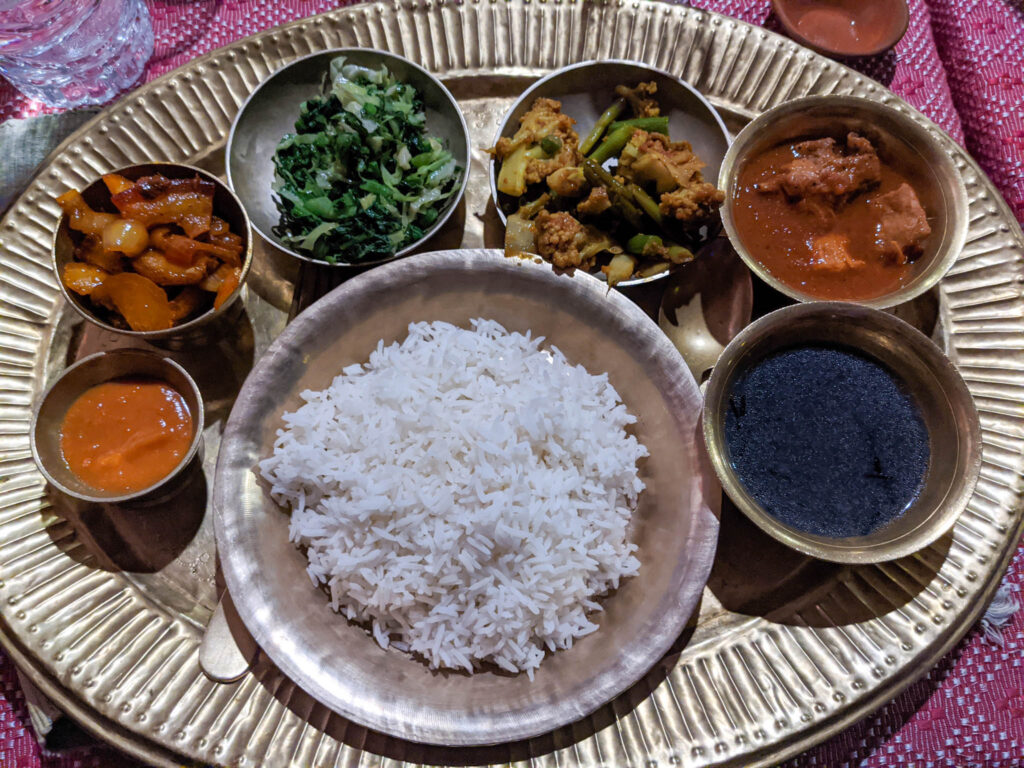
Recommended Dinner Options:
- Dal Bhat! (Yummm)
- Veggie Fried Noodles
- Veggie Fried Rice
- Veggie Momo
- Potato Momo
- Rara Noodle Soup
- Vegetable Noodle Soup
- Veggie Sherpa Stew
Special shout out to the popcorn that is typically served with or before dinner! Popcorn is my favorite snack, and it was a pleasant surprise to learn that it is extremely popular in the region! They offer fully-popped popcorn (similar to a movie theater), but also Nepali popcorn, which consists of half popped kernels. Both are incredible.
Drink Options on the Everest Base Camp Trek
Tea
Along the hike, you can sample a smattering of the local, freshly brewed teas. And let me tell you – they are insanely good. Some of my personal favorites are below:
- Lemon-ginger-honey tea (hands down my favorite!)
- Milk Tea
- Chai
- Hot water with lemon
- Hot water with Ginger
- Tibetan Butter Tea (a tea made with salt, yak butter, and tea leaves)
While all of the above options were great, we found ourselves eventually sticking with the lemon-ginger-honey tea. It just knocked it out of the park every single time! Nothing else could compare to its perfection.
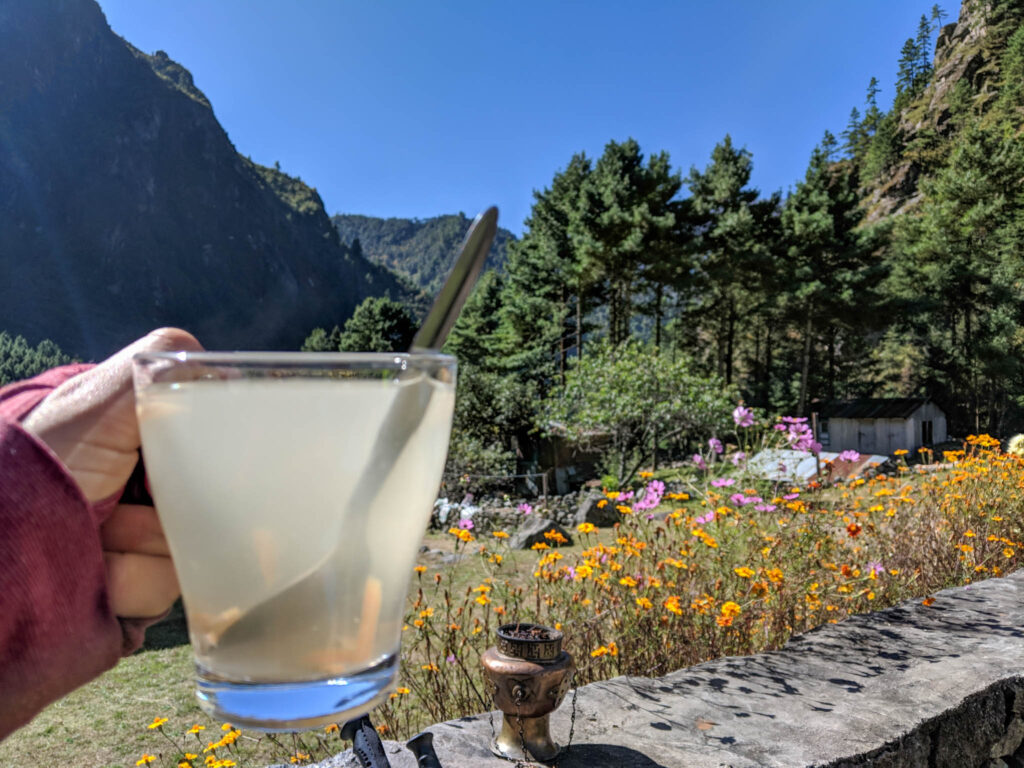
Coffee
Drinking coffee can cause dehydration, and exacerbate the effects of altitude. However, when you begin you descent on the trail, you can absolutely add coffee back to the agenda. You can purchase large canisters for $1-2 USD at tea houses. Or, if you shell out a couple more dollars, you can purchase fancier coffee drinks. My first return to coffee was on the second to last day of the trek. I purchased a mocha, which the tea house owner said “was a favorite”. AND IT WAS. Look at that happy face.
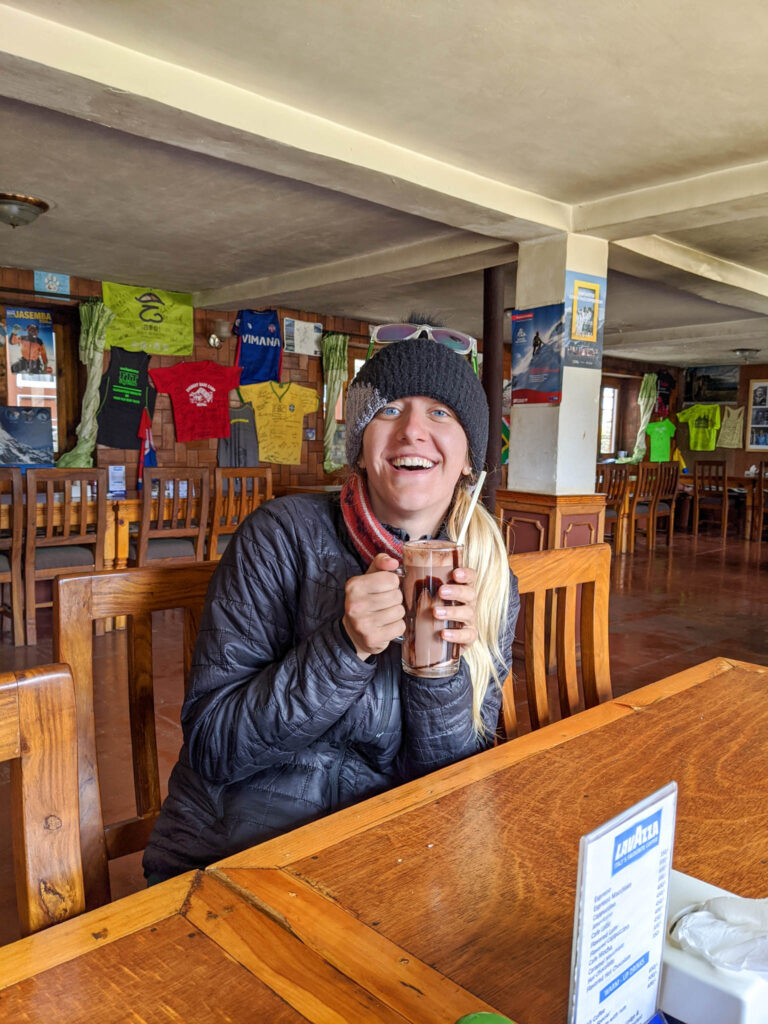
Alcohol
It is not recommended to drink alcohol along the trail, as it can dehydrate you and exacerbate the symptoms of altitude sickness. We celebrated the end of our trail with a handful of Everest Beers in Lukla before our return flight, and that was totally fine. But best to wait until that point.
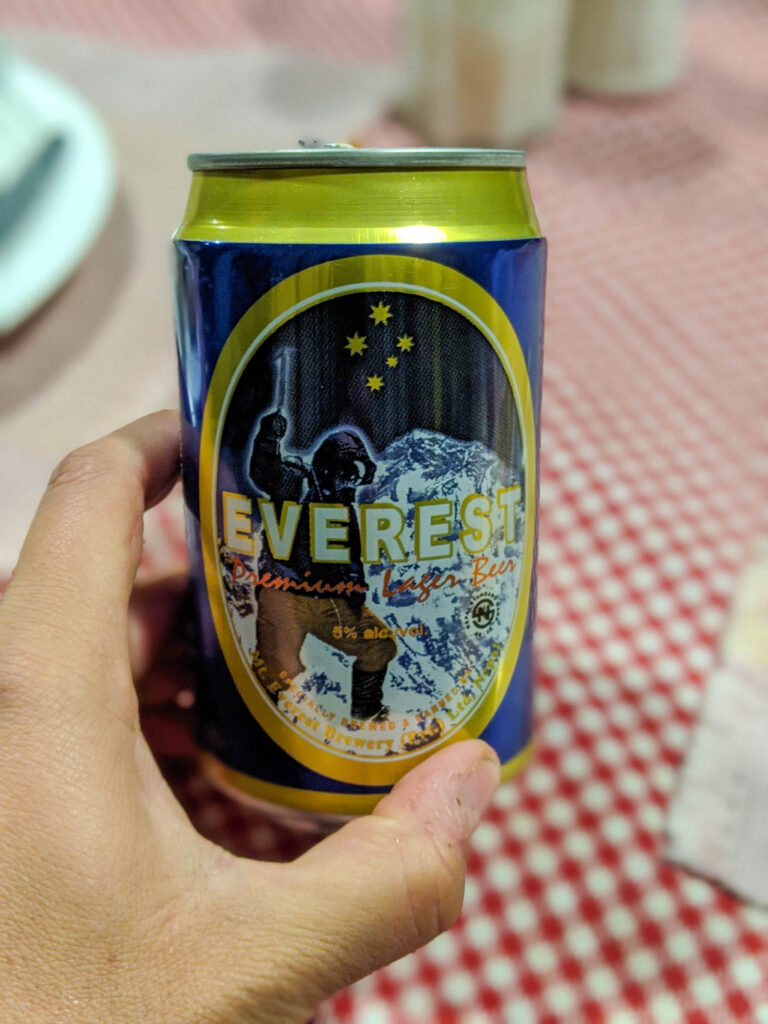
That being said, we kept bumping into a 70-year-old Irish Man along our route who drank beer the whole way up the trail. He made it to just about 1.5 hours from base camp before being forced to turn around from altitude sickness. So who’s to say?
Water
Water is your most important asset along the route. We dehydrate much quicker at higher altitudes, and it is important to always have a supply at the ready so you can drink continuously throughout the day. That being said, it is of utmost importance to purify your drinking water before consuming. Purifying water is the most full-proof way to remove potential or present bacteria, viruses, and parasites. You can bring iodine tablets, a steripen, or purification drips (which is what we used).
I’ll reinforce the importance here by sharing an anecdote from my trek. On one sleepy day, I wasn’t paying attention and purified my water incorrectly. Not even 24 hours later, and I was spending one incredibly shitty (literally and figuratively) night trekking to and from the bathroom. I probably put in more steps to my Fitbit that night than I did the entire rest of the trek!
I encourage you not to purchase plastic water bottles on your trek up the mountain, as it adds to the pollution and waste being generated. Purification methods are much more sustainable, and work just as well!
Check out my Everest Base Camp safety guide for more information.
What Snacks Should I Bring on the Everest Base Camp trek?
You’re going to want to stash a few snacks away in your day pack to consume along the trail, especially at higher altitudes when towns become less frequent. You can pack your favorites ahead of time, or purchase snacks in Kathmandu or Namche.
I recommend bringing quick protein snacks, like nuts or protein bars, as you will be consuming a lot of carbs in tea houses. Some of my favorites were:
- Cliff Bars
- Builder Bars
- Planters Peanuts
- Quest Bars
Avoid bringing anything overly processed, like potato chips, or extremely sugary snacks, like candy. I found that these added little to no fuel to my body, and just made me more sluggish.
Important note: If you are purchasing snacks along the trail, I recommend stocking up in Namche or Kathmandu. Prices of items become increasingly more expensive at higher altitudes, as every single item must be carried there by foot. For example: a bottle of Coke at Gorak Shep (the highest town) cost just around $8USD. If you are cost-conscious, you’ll want to plan ahead!
That’s All, folks!
Hopefully this guide gave you a good idea of Everest Base Camp food along the trail! Nepalese food is one of my favorite cuisines. I know you will enjoy sampling everything of the menus!
Planning a trip to Everest Base Camp? Check out my full Everest Base Camp guide for everything you need to know about the trek!
Have you trekked to Everest Base Camp? If so, leave a comment with some of your favorite meals along the route!
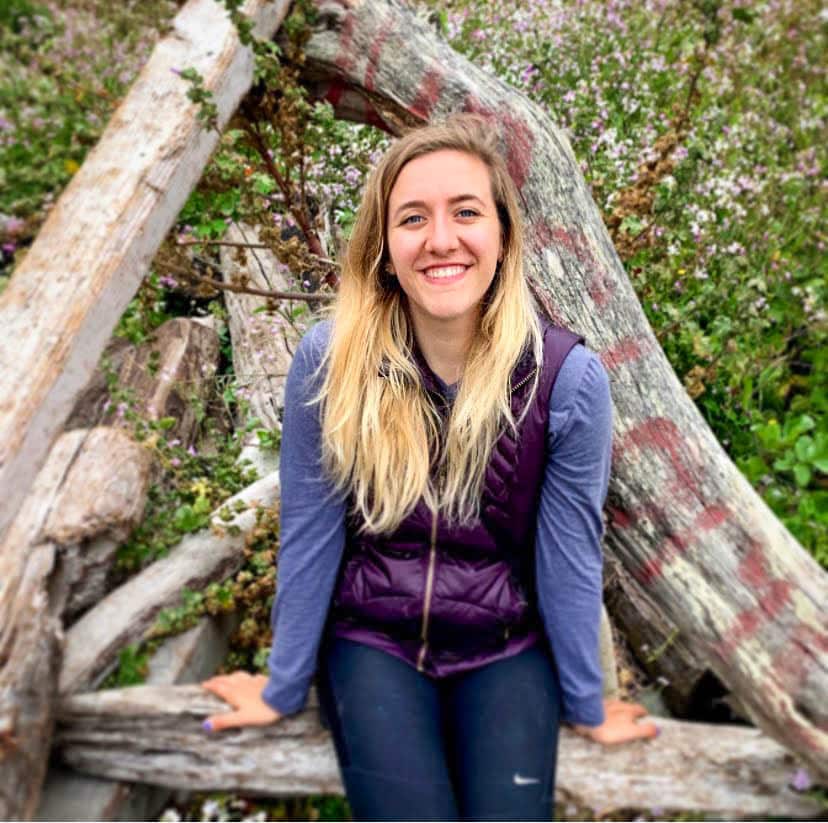
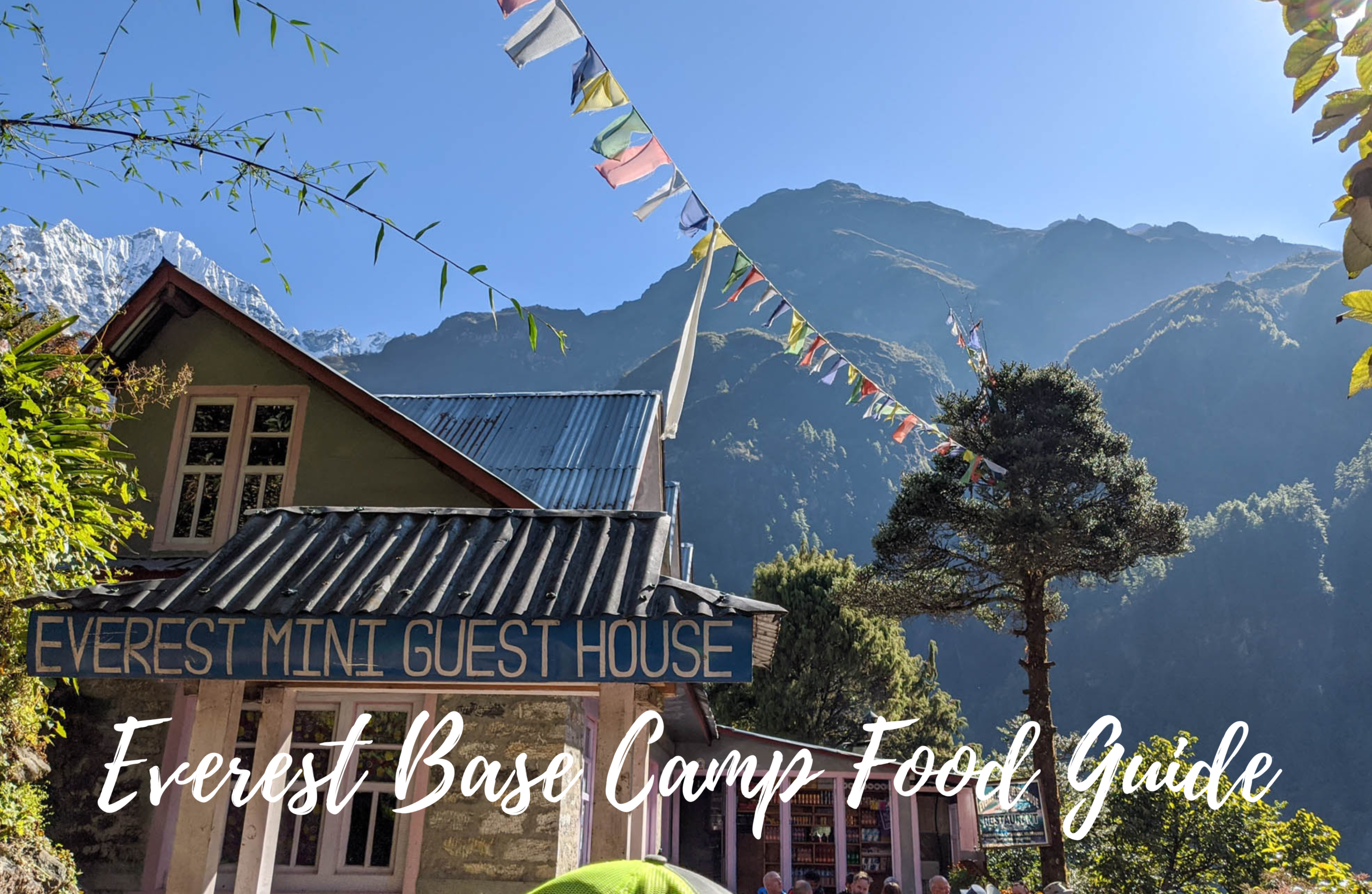
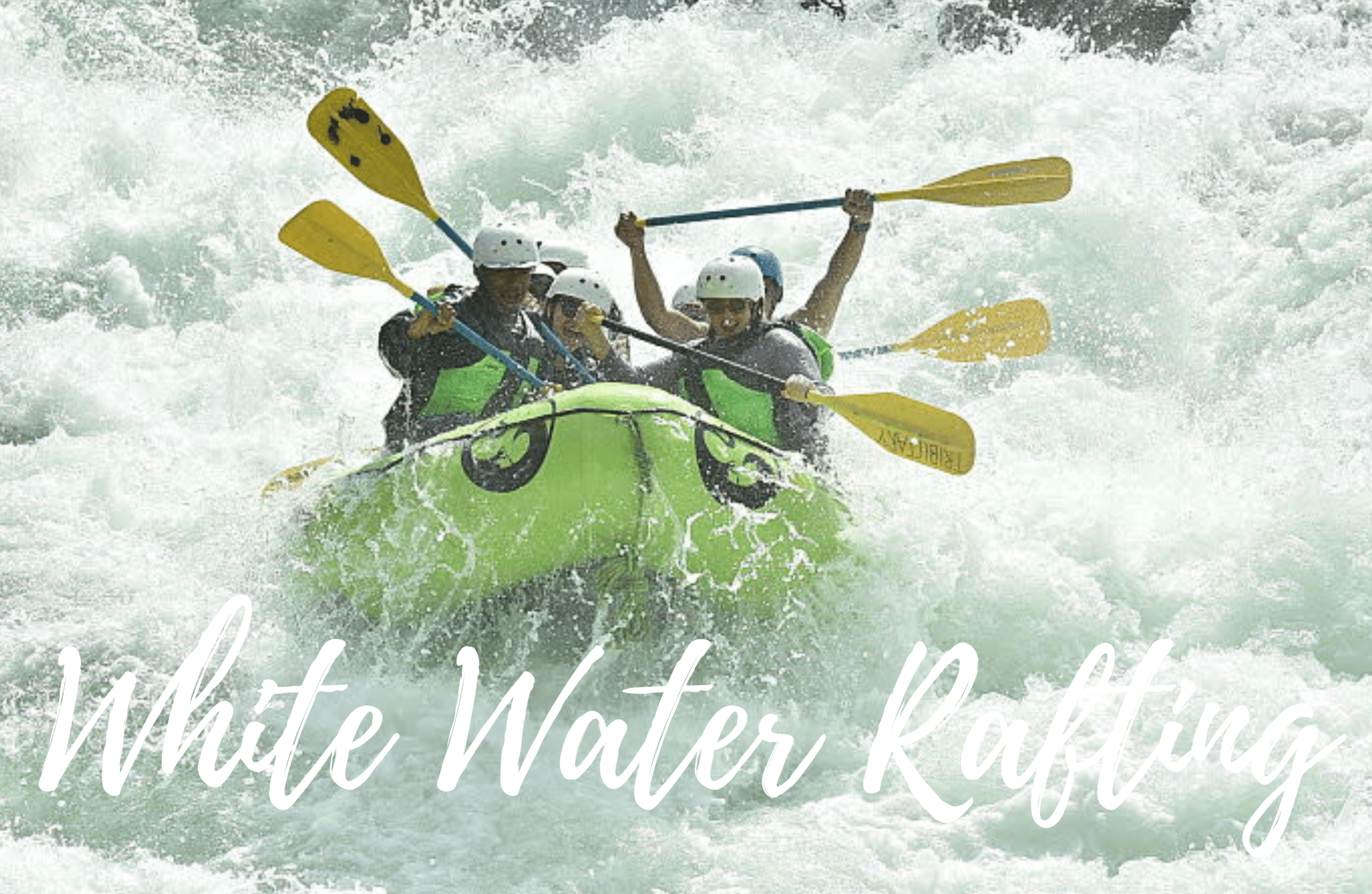
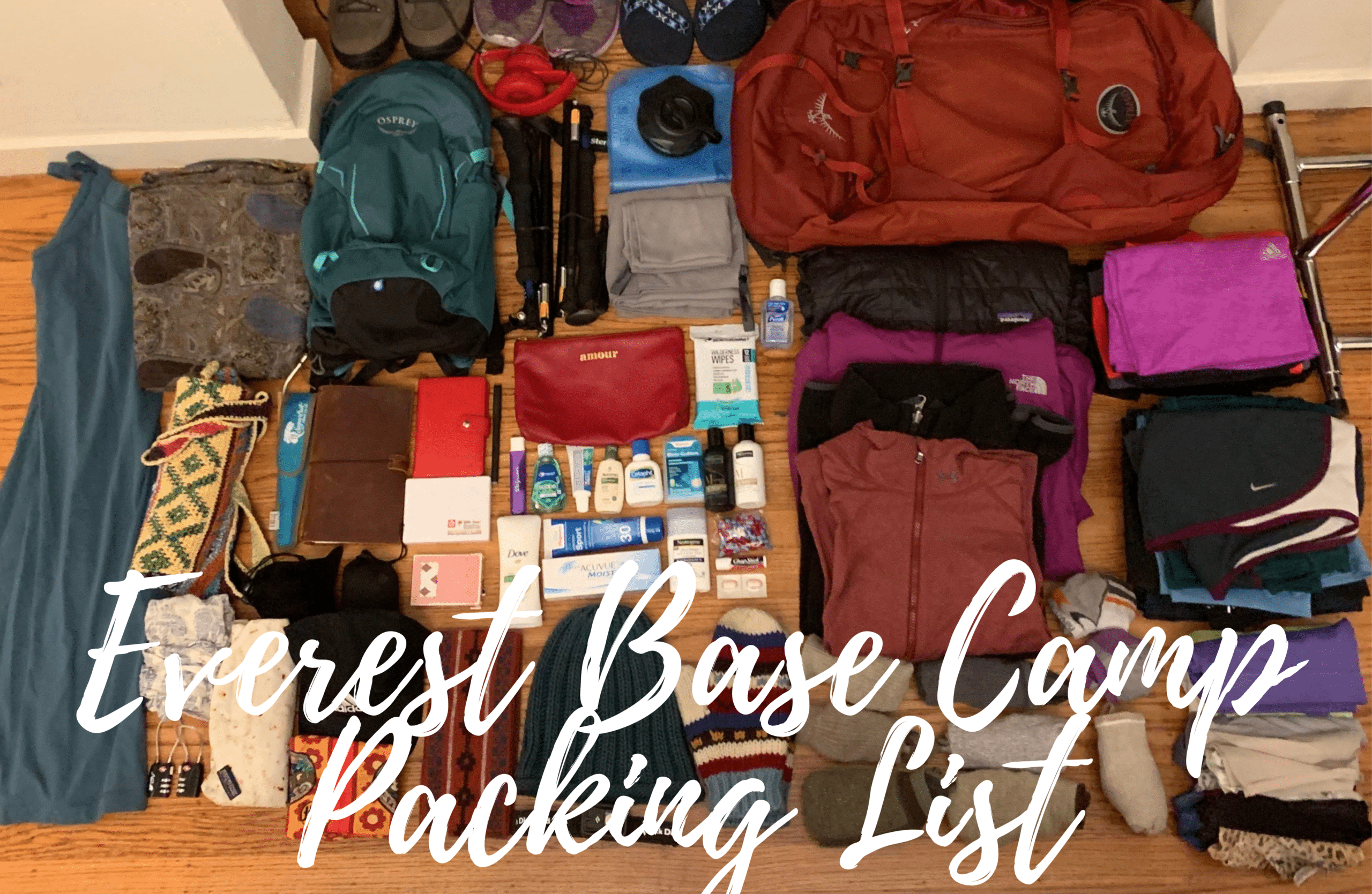
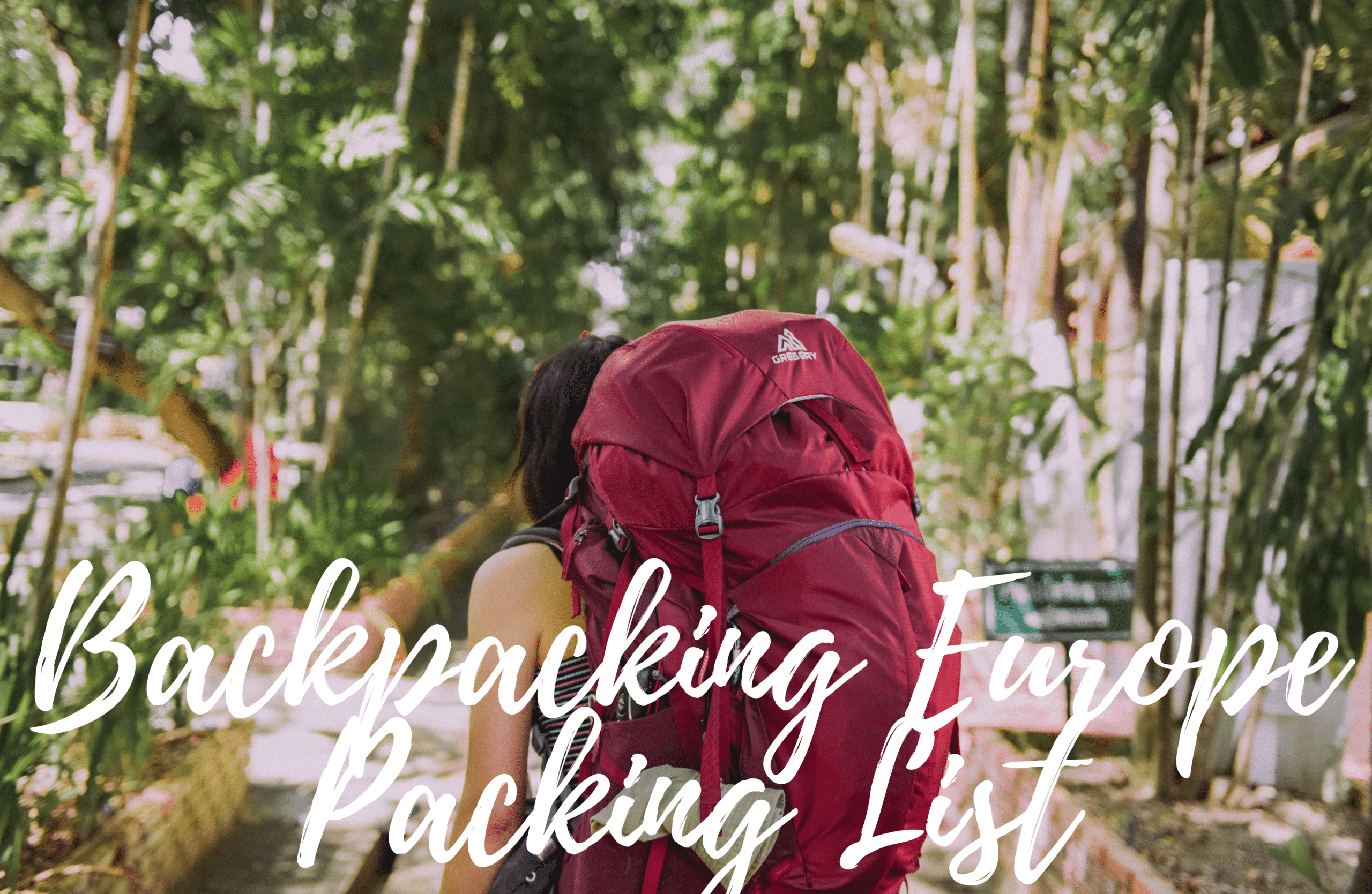
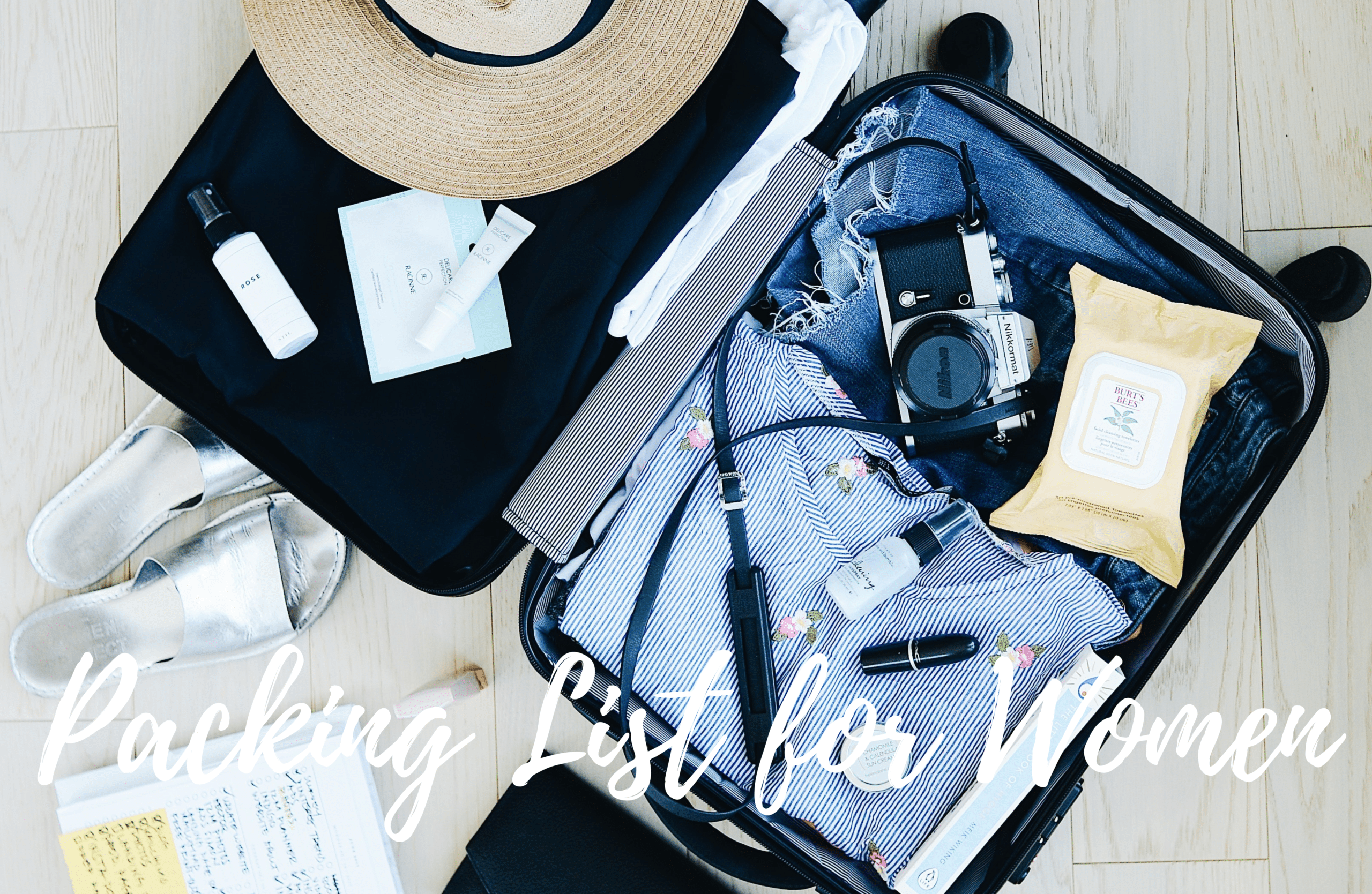
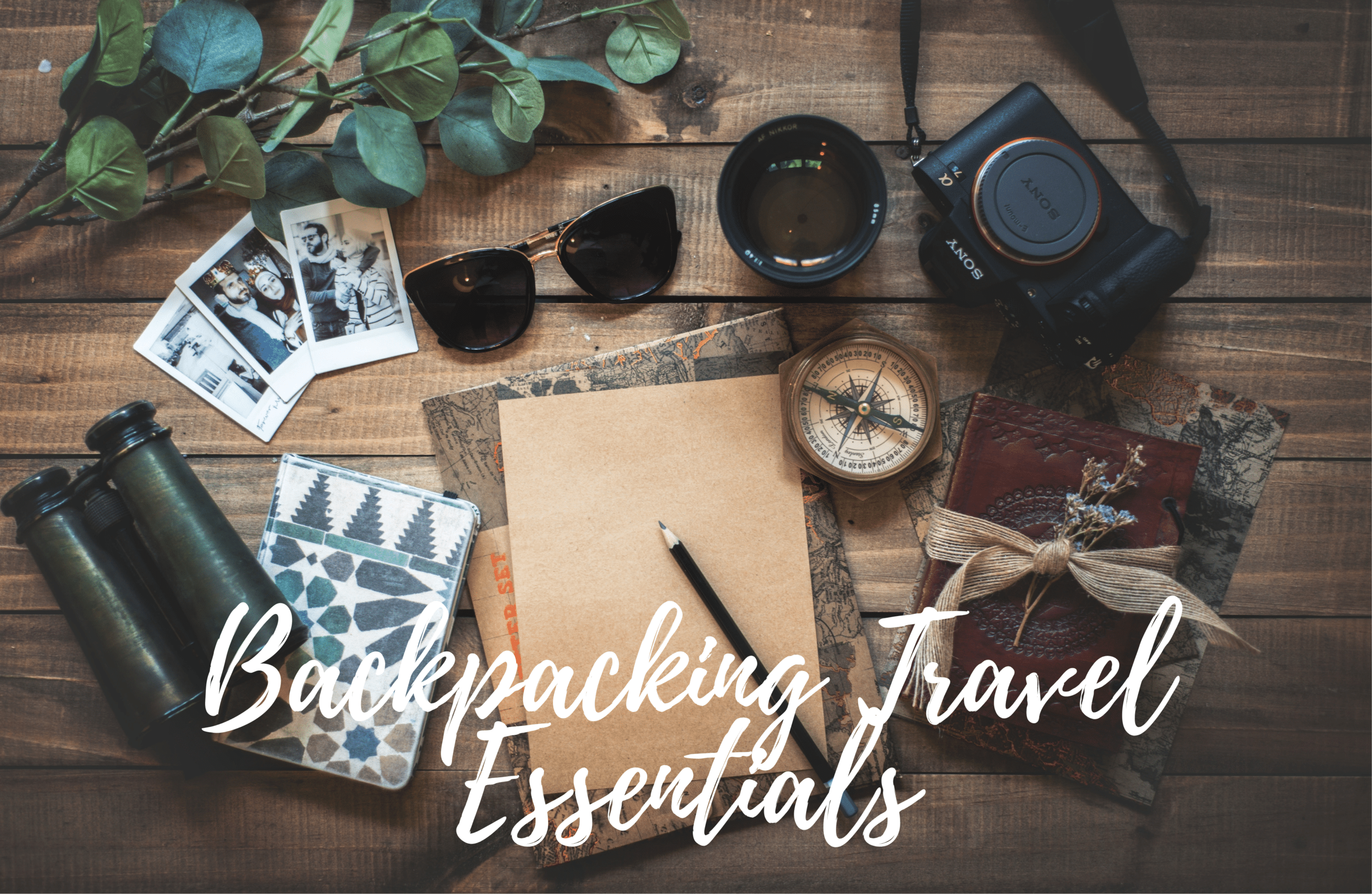
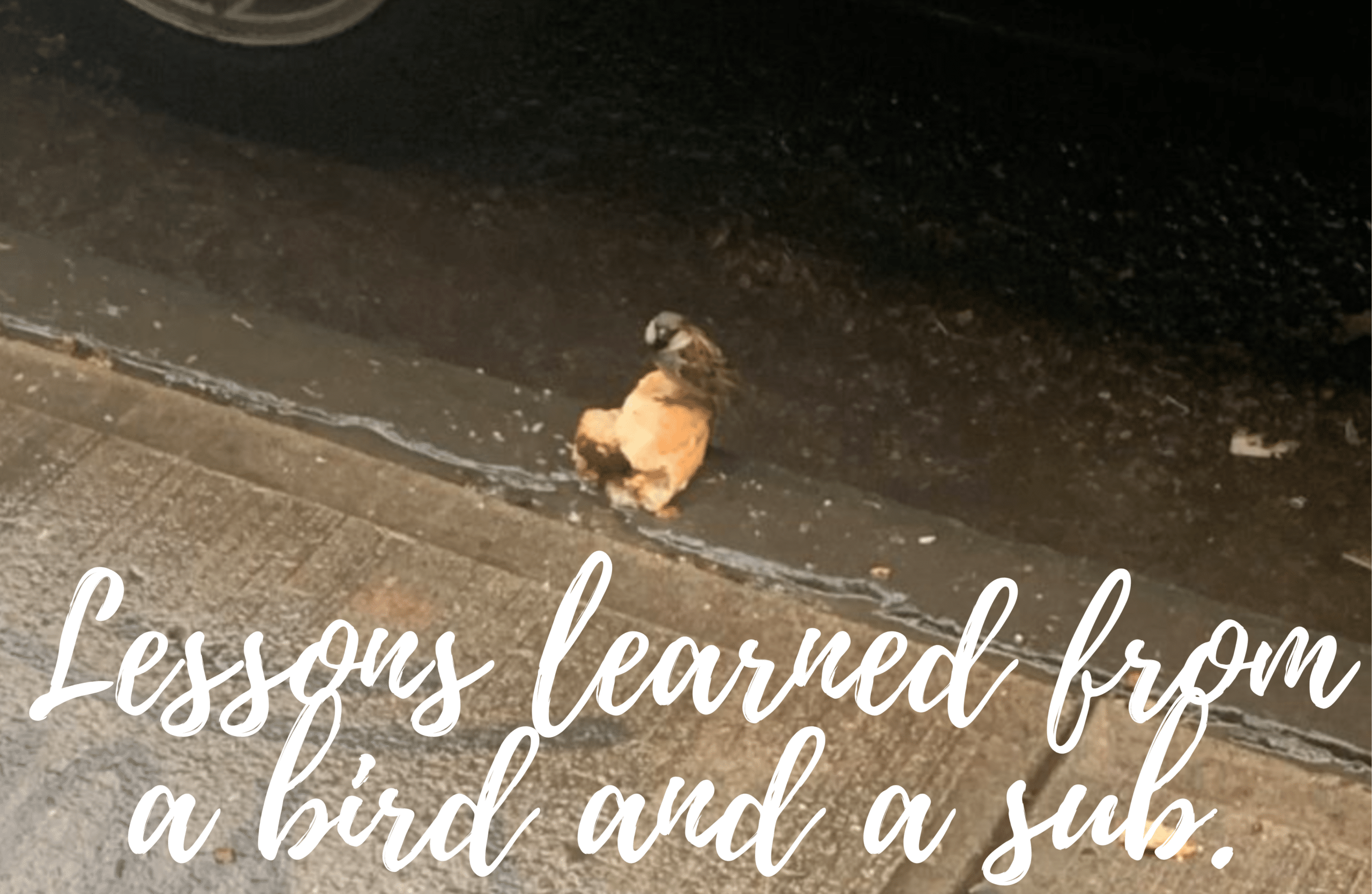
0